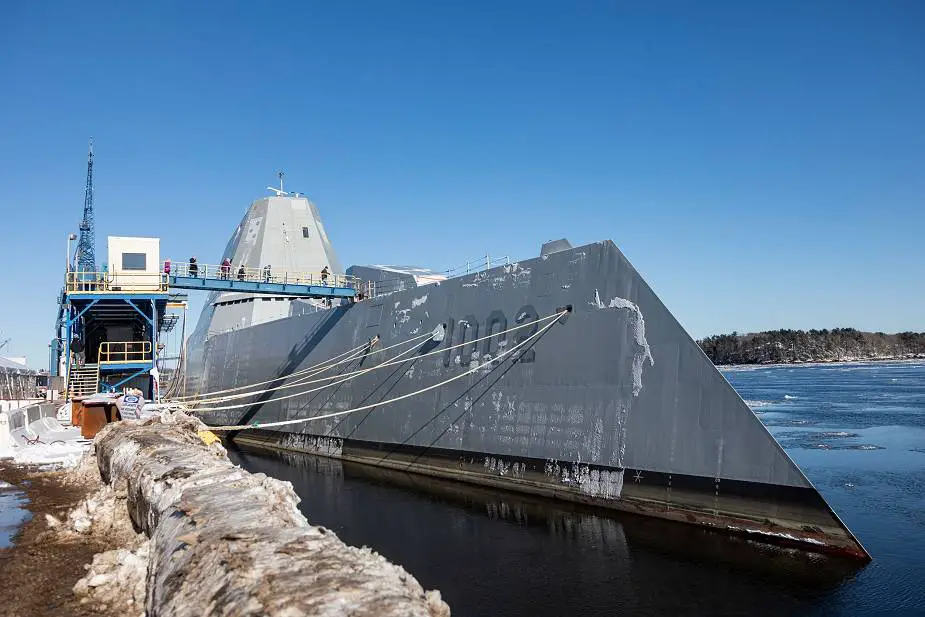Breaking news
Future USS Lyndon B Johnson DDG 1002 Zumwalt-class destroyer is ready for the final fitting out.
According to a Tweet published by General Dynamics Bath Iron Works (GDBIW) on January 8, 2021, the future USS Lyndon B. Johnson (DDG 1002) Zumwalt-class destroyer (DDG-1000) for the U.S. Navy is ready to leave GDBIW Bath Iron Works in Maine and head to Ingalls in Mississippi for the final fitting out.
Follow Navy Recognition on Google News at this link
 The future USS Lyndon B. Johnson DDG 1002 Zumwalt-class destroyer for the U.S. Navy at GDBIW Bath Iron Works. (Picture source GDBIW)
The future USS Lyndon B. Johnson DDG 1002 Zumwalt-class destroyer for the U.S. Navy at GDBIW Bath Iron Works. (Picture source GDBIW)
The USS Lyndon B. Johnson (DDG-1002) is the third and final Zumwalt-class destroyer built for the United States Navy. The contract to build her was awarded to Bath Iron Works located in Bath, Maine, on 15 September 2011. The ship was launched in December 2018 and christened on 27 April 2019.
According to a U.S. Congress Report, the United States Navy procured three DDG-1000 class destroyers in FY2007-FY2009 (FY Fiscal Year) and plans no further procurement of DDG-1000s.
The DDG-1000s are multi-mission destroyers with an originally intended emphasis on naval surface fire support (NSFS) and operations in littoral waters. Consistent with that mission orientation, the ship was designed with two new-design 155mm guns called Advanced Gun Systems (AGSs). The AGSs were to fire a new 155mm, gun-launched, rocket-assisted guided projectile called the Long-Range Land-Attack Projectile (LRLAP, pronounced LUR-lap).
In November 2016, however, it was reported that the Navy had decided to stop procuring LRLAP projectiles because the projected unit cost of each projectile had risen to at least $800,000. In December 2017, it was reported that, due to shifts in the international security environment and resulting shifts in Navy mission needs, the mission orientation of the DDG-1000s will be shifted from an emphasis on NSFS to an emphasis on surface strike, meaning the use of missiles to attack surface ships and perhaps also land targets.
In April and May 2021, it was reported that the Navy plans to remove the AGSs on the three ships and replace them with vertical launch tubes for the Navy’s new hypersonic Conventional Prompt Strike (CPS) missile, with a goal of fielding CPSs on a DDG-1000 class ship by 2025.
The future USS Lyndon B. Johnson (DDG 1002) is a Zumwalt-class destroyer (DDG-1000) designed as multi-mission stealth ships with a focus on land attack. It is a multi-role class that was designed for secondary roles of surface warfare and anti-aircraft warfare and originally designed with a primary role of naval gunfire support.
The DDG-1000 incorporates a significant number of new technologies, including a wave piercing, tumblehome hull design for reduced detectability,30 a superstructure on the first two ships, but not the third that is made partly of large sections of composite (i.e., fiberglass-like) materials rather than steel or aluminum, an integrated electric-drive propulsion system,31 a total ship computing system for moving information about the ship, automation technologies enabling its reduced-sized crew, a dual-band radar (that was later changed to a single-band radar), a new kind of vertical launch system (VLS) for storing and firing missiles, and two copies of a new 155mm gun called the Advanced Gun System (AGS).
The propulsion system of the DDG 1002 incorporates two Rolls-Royce Marine Trent-30 gas turbines, two 2 Rolls-Royce RR4500 gas turbine generator,s and two 34.6MW advanced induction motors (AIM). The ship can reach a top speed of 30.3 knots (56.1 km/h). With an estimated full load displacement of 15,656 tons, the DDG-1000 series design is substantially larger than the U.S. Navy’s Aegis cruisers and destroyers, which have displacements of up to about 9,700 tons, and are larger than any Navy destroyer or cruiser since the nuclear-powered cruiser Long Beach (CGN-9), which was procured in FY1957. The ship has a length of 182.9 m, a beam of 80.7 m, and a draft of 27.6 m. The ship has a crew of 175 sailors including 147 sailors to operate the ship, plus 28 people for the aviation detachment.
The DDG 1002 is armed with 20 MK 57 VLS (Vertical launching System) modules, with 4 vertical launch cells in each module, 80 cells total. Each cell can hold one or more missiles, depending on the size of the missiles.
The ship can launch Evolved Sea Sparrow Missile (ESSM) surface-to-air missiles, Tactical Tomahawk Vertical Launch Anti-Submarine Rocket (ASROC) cruise missiles. The ship is also armed with two 155 mm Advanced Gun Systems and two Mk 46 Mod 2 Gun Weapon Systems.
The rear part of the DDG 1002 is fitted with a large aviation deck and a hangar capable of housing two SH-60 LAMPS helicopters or MH-60R helicopters or three MQ-8 Fire Scout VTUAV unmanned helicopters.



























